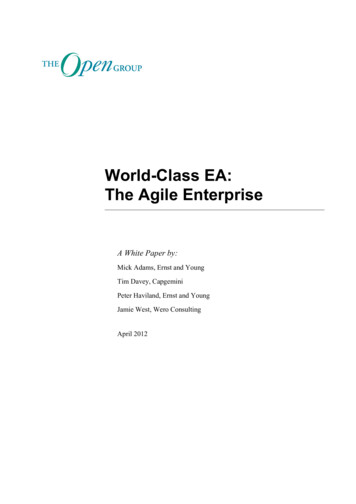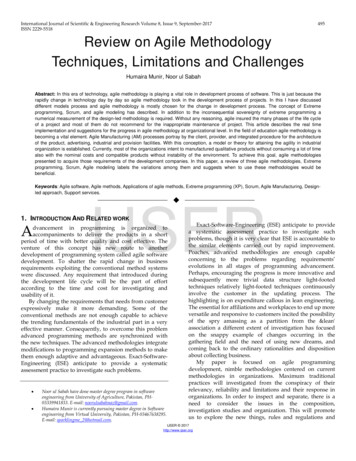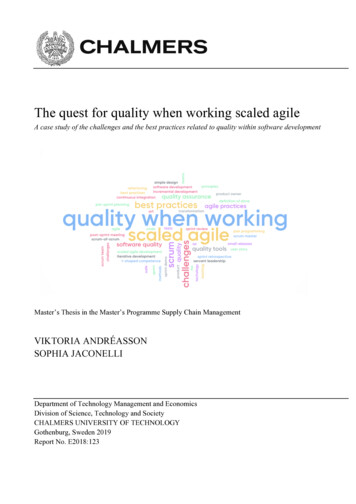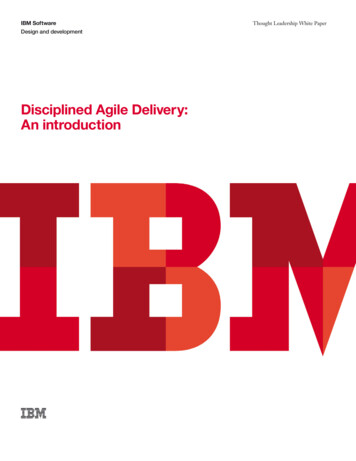
Transcription
World-Class EA:The Agile EnterpriseA White Paper by:Mick Adams, Ernst and YoungTim Davey, CapgeminiPeter Haviland, Ernst and YoungJamie West, Wero ConsultingApril 2012
World-Class EA: The Agile EnterpriseCopyright 2012, The Open GroupThe Open Group hereby authorizes you to use this document for any purpose, PROVIDED THAT any copyof this document, or any part thereof, which you make shall retain all copyright and other proprietary noticescontained herein.This document may contain other proprietary notices and copyright information.Nothing contained herein shall be construed as conferring by implication, estoppel, or otherwise any licenseor right under any patent or trademark of The Open Group or any third party. Except as expressly providedabove, nothing contained herein shall be construed as conferring any license or right under any copyright ofThe Open Group.Note that any product, process, or technology in this document may be the subject of other intellectualproperty rights reserved by The Open Group, and may not be licensed hereunder.This document is provided "AS IS" WITHOUT WARRANTY OF ANY KIND, EITHER EXPRESSED ORIMPLIED, INCLUDING, BUT NOT LIMITED TO, THE IMPLIED WARRANTIES OFMERCHANTABILITY, FITNESS FOR A PARTICULAR PURPOSE, OR NON-INFRINGEMENT. Somejurisdictions do not allow the exclusion of implied warranties, so the above exclusion may not apply to you.Any publication of The Open Group may include technical inaccuracies or typographical errors. Changesmay be periodically made to these publications; these changes will be incorporated in new editions of thesepublications. The Open Group may make improvements and/or changes in the products and/or the programsdescribed in these publications at any time without notice.Should any viewer of this document respond with information including feedback data, such as questions,comments, suggestions, or the like regarding the content of this document, such information shall be deemedto be non-confidential and The Open Group shall have no obligation of any kind with respect to suchinformation and shall be free to reproduce, use, disclose, and distribute the information to others withoutlimitation. Further, The Open Group shall be free to use any ideas, concepts, know-how, or techniquescontained in such information for any purpose whatsoever including but not limited to developing,manufacturing, and marketing products incorporating such information.If you did not obtain this copy through The Open Group, it may not be the latest version. For yourconvenience, the latest version of this publication may be downloaded at www.opengroup.org/bookstore.This White Paper is an informational document and does not form part of the TOGAF documentation set.Readers should note that this document has not been approved through the formal Open Group StandardsProcess and does not represent the formal consensus of The Open Group Architecture Forum.ArchiMate , Jericho Forum , Making Standards Work , The Open Group , TOGAF , UNIX , and the “X” device are registered trademarks and Boundaryless Information Flow , DirecNet , FACE , and TheOpen Group Certification Mark are trademarks of The Open Group in the United States and othercountries. All other brands, company, and product names are used for identification purposes only and maybe trademarks that are the sole property of their respective owners.World-Class EA: The Agile EnterpriseDocument No.:W123Published by The Open Group, April 2012.Any comments relating to the material contained in this document may be submitted to:The Open Group, 44 Montgomery St. #960, San Francisco, CA 94104, USAor by email to:ogpubs@opengroup.orgwww.opengroup.orgA White Paper Published by The Open Group2
World-Class EA: The Agile EnterpriseTable of ContentsExecutive Summary4Introduction5Document Structure .5Industry Challenges6Agile Behaviors7Responsiveness to Change .7Value-Driven .7Practical Experimentation .7Empowered, Self-Managing Teams .8Customer Communication and Collaboration .8Continuous Improvement .9Respect for People .9Organizational Capabilities10People .10Process .10Technology .10www.opengroup.orgConclusion11Appendix A: Agile Behaviors12Appendix B: Agile Architecture Capabilities14About the Authors18About The Open Group18A White Paper Published by The Open Group3
World-Class EA: The Agile EnterpriseBoundaryless Information Flow achieved through global interoperabilityin a secure, reliable, and timely mannerExecutive SummaryThis White Paper is part of a series of “World-Class” papers generated by the ValueRealization Working Group within The Open Group Architecture Forum. The series looksat how architectural techniques and best practices may be applied to drive practical valuefor an enterprise.1The concept of “agile” has recently come to the fore, typically in connection withtechnical activities, such as software development. Subsequently, the agile approach hasbeen extended and applied to, for example, solution architecture activities. However, wesuggest that agile is in fact a way of working, a mindset. It applies to more than justsoftware development, or architecture, or any other one area of activity. The real benefitcomes from applying an end-to-end agile delivery approach throughout the enterprise.Furthermore, an enterprise does not become more agile overnight. Individuals, teams,departments, and lines of business need to develop new capabilities and embed behavioralchange. Agile approaches need to be applied holistically to an organization, to avoidinconsistencies in the way an individual versus their department (or line of business) willbehave.The Open Group mission statement enabling Boundaryless Information Flow is alsosupported by detailing how agile thinking can be holistically deployed into anorganization.1The series to date includes: World-Class Enterprise Architecture (W102), World-Class Enterprise Architecture: Framework Guidance & TOGAF 9Example (W103), and World-Class Enterprise Architecture: Using Architecture to Contract Cloud Services (W122), all available fromwww.opengroup.org/bookstore.www.opengroup.orgA White Paper Published by The Open Group4
World-Class EA: The Agile EnterpriseIntroductionThis White Paper is part of a series of “World-Class” papers generated by the Value Realization WorkingGroup within The Open Group Architecture Forum. The series looks at how architectural techniques and bestpractices may be applied to drive practical value for an enterprise.The concept of “agile2” has recently come to the fore, typically in connection with technical activities, suchas software development. Subsequently, the agile approach has been extended and applied to, for example,solution architecture activities.However, we suggest that agile is in fact a way of working, a mindset. It applies to more than just softwaredevelopment, or architecture, or any other one area of activity. The real benefit comes from applying an endto-end agile delivery approach throughout the enterprise.Furthermore, an enterprise does not become more agile overnight. Individuals, teams, departments, and linesof business need to develop new capabilities and embed behavioral change. Agile approaches need to beapplied holistically to an organization, to avoid inconsistencies in the way an individual versus theirdepartment (or line of business) will behave.The Open Group mission statement enabling Boundaryless Information Flow is also supported by detailinghow agile thinking can be holistically deployed into an organization.Document StructureIn this document we first consider the drivers for change. We revisit four themes, based on industrychallenges, which mean that the ways of working which have worked in the past need to be reconsidered.We then identify the behaviors which characterize an agile approach, and assess how each behavior can assistwith the industry challenges.Having established the benefits of an agile approach, we conclude by identifying the organizationalcapabilities (people, process, and technology) which need to be developed to put this into practice.Finally, two appendixes provide more detail on the agile behaviors and specific agile capabilities.2While agile in the context of this White Paper may use some of the attributes contained in the “Manifesto for Agile Software Development” (Beck,Kent, et al., 2001), we are not using this specific definition here.www.opengroup.orgA White Paper Published by The Open Group5
World-Class EA: The Agile EnterpriseIndustry ChallengesWhen considering the transformation of an enterprise to more agile ways of working, an obvious question isto ask “why bother?”. Many enterprises are not agile today, and indeed there are advantages to operatingstable processes and rigid control systems. These approaches may previously have served well, and haveallowed an enterprise to achieve success in the past.However, previous work3 has analyzed the implications of an increasing pace of change across a number ofindustry sectors. From this analysis have emerged four themes which are common across all industries, andwhich tend to drive behavior of an enterprise.To reprise, these themes are: Customer-Centric: The goal of this theme is to attract new customers and leverage the existing customerbase. The business challenge is to provide a positive, seamless, and consistent customer experience byinstantly recognizing each individual customer, their current situation, and potential needs during eachinteraction that a customer has with the organization. The organization will need to show that they reallycare and consider themselves to be in a partnership with their customers. Internal Efficiency: The goal of this theme is to focus on quality as the primary driver within anorganization. The business challenge is to optimize all internal processes as part of a Total QualityManagement (TQM) system within an organization. Product-Centric: The goal of this theme is to increase innovation and reduce development lead times fornew products and services. The business challenges are to co-ordinate the product R&D processes thatlook at re-use and lessons learned, and validate the customer demand and return on investment (ROI). Regulatory Requirements: The goal of this theme is to meet all legal and compliance requirements inorder to continue to stay in business. The business challenge is to identify all the relevant stakeholders,agree objectives for compliance with the regulators and other compliance bodies, and ensure thatauditable evidence is captured in order to prove compliance.In the following sections we consider the implications of these themes in more detail. We look at howapplying agile behaviors can contribute to addressing their challenges, and then consider the organizationalcapabilities needed to put this more agile mode of operation into practice.3White Paper: World-Class Enterprise Architecture (W102), The Open Group, April 2010; refer to: pengroup.orgA White Paper Published by The Open Group6
World-Class EA: The Agile EnterpriseAgile BehaviorsExperience with agile best practices reveals a number of behaviors which characterize an agile approach. Inthis section, we introduce these behaviors – describing each one, and illustrating how it may be applied toeach of the four themes outlined in the previous section.4Responsiveness to ChangeA flexible approach which anticipates and explicitly plans for change. Typically involving short iterationsand frequent reprioritization of activities. Customer-Centric: To be customer-centric requires responding to the market – acting rapidly to adjustbased on customer priorities and feedback. Internal Efficiency: Efficiency is typically aided by stability; therefore, these objectives may sometimesbe in conflict. However, where the environment is unstable then it is important to design for change. Anoptimized but static process quickly becomes highly inefficient when the environment changes – only byconstantly adapting can efficiency be maintained. Product-Centric: Markets are increasingly volatile – products must respond to change and quickly evolveto meet customer expectations and competitor developments. Regulatory Requirements: Where the regulatory environment is slow-moving, then this behavior may notbe relevant. However, in other cases, particularly in innovative product areas, regulation may bedeveloping and/or the emphasis quickly changing based on public and media attention.Value-DrivenActivity is driven by delivering value. Priorities are continually re-assessed to deliver high-value items first.Work on intermediate products and documentation is minimized. Customer-Centric: Here the emphasis is on maximizing the “face-time” of skilled front-line staff withcustomers. Work on internal process and bureaucracy is minimized as far as possible. Internal Efficiency: There is a clear and direct link between internal efficiency and the elimination oflow-value work on intermediate products. Product-Centric: Products are brought to market more quickly by ensuring that features are linked tocustomer needs and value. “Gold plating” and features of marginal value are avoided. Regulatory Requirements: The value (and/or risk) relating to each aspect of new regulation is assessed.Work is focused on the priority items first.Practical ExperimentationA preference for trying things out and learning from experience, as opposed to extensive theoretical analysis.Sometimes characterized as “fail fast”. Customer-Centric: New service process and promotions are constantly trialed and evaluated (for4See also Appendix A: Agile Behaviors for a more complete definition of each agile behavior.www.opengroup.orgA White Paper Published by The Open Group7
World-Class EA: The Agile Enterpriseexample, using small samples of the customer base). Internal Efficiency: New techniques and processes are trialed, measured, and adopted or discarded basedon the results. Product-Centric: Product innovation is encouraged, with a wide range of new products being trialed earlywith real customers. A process of “natural selection” enables successful products to emerge. Regulatory Requirements: Regulation is an area where careful analysis and right-first-timeimplementation may be essential – particularly in, for example, safety-critical areas. However, in othercases some experimentation may be possible; for example, regarding the merits of differentimplementation approaches to a regulatory requirement.Empowered, Self-Managing TeamsSkilled, multi-disciplinary teams work closely together, taking responsibility for their own decisions andoutputs. Customer-Centric: Customer-facing teams are empowered to organize their own work in ways that servethe customer best. Internal Efficiency: Production teams have responsibility for managing and optimizing the productionprocess. Product-Centric: Product development is accelerated by cohesive multi-disciplinary teams, as opposed tobureaucratic hand-offs between specialist departments. Regulatory Requirements: The implication of new regulatory requirements is rapidly assessed by askilled team from all relevant business units working together on the impact assessment.Customer Communication and CollaborationWorking closely with the customer and adapting to their needs. Valuing collaboration and feedback overformalized documentation and contracts. Customer-Centric: Clearly this behavior is central to the customer-centric theme. Customers arecontacted and consulted as opposed to relying purely on forms and second-hand information. Internal Efficiency: Here the “customer” is likely to be another downstream internal department. Bybetter understanding the downstream department’s challenges and needs, the efficiency of the end-to-endprocess is improved. Product-Centric: This behavior is clearly central to the product-centric theme – ensuring that customerfeedback is sought directly and ensuring customer input to product development decisions. Regulatory Requirements: In this context an important “customer” will be the regulatory body. Oftennew regulatory requirements have areas of ambiguity, and adoption may be phased. By developing astrong working relationship with the regulator, misunderstandings can be avoided.www.opengroup.orgA White Paper Published by The Open Group8
World-Class EA: The Agile EnterpriseContinuous ImprovementThe internal drive to improve the way an organization performs. Customer-Centric: Customers will quickly come to consider any service improvements as “normal”.Continuous improvement is necessary to avoid complacency and loss of customers to competitors. Internal Efficiency: Constant small improvements (kaizen) is proven as a highly effective approach todriving operational efficiency. Product-Centric: Few products are perfect in their first version. More often the ability to adapt andimprove a product over time drives its success. Regulatory Requirements: Regulatory requirements are often extensive and difficult to implement in asingle step. Additionally, it may be necessary to put in place ad hoc manual processes initially andgradually incorporate into business-as-usual.Respect for PeoplePeople are put first, above process and tools. They are treated with respect; flexibility, knowledge transfer,and personal development are high priority. Customer-Centric: Respect for the customer is the basis of good customer service. However, respect forand development of the organization’s staff is equally important, with the attitude of staff being reflectedin their dealings with customers. Internal Efficiency: While processes and tools are also important, it is the people operating them who arein the optimum position to understand and suggest improvements. Respecting, developing, andharnessing their abilities and ideas is therefore a powerful driver for efficiency improvements. Product-Centric: Products are developed by people – their skills and commitment are directly reflected inthe product quality. Regulatory Requirements: While the aim may be to create watertight processes and controls, it isgenerally the case that educated, vigilant, and committed employees play an essential role in regulatorycompliance.www.opengroup.orgA White Paper Published by The Open Group9
World-Class EA: The Agile EnterpriseOrganizational CapabilitiesHaving outlined how the application of agile behaviors can provide value in addressing the industrychallenges, in this section we consider the organizational capabilities required to put these new behaviors intopractice. These capabilities span the aspects of people, process, and technology and, while all aspects areimportant, the priorities typically vary across each of the four HighMediumInternal umProduct-CentricRegulatory RequirementsPeoplePeople need to be developed to understand agile ways of working – accepting the importance ofcommunication and collaboration, and the greater initial ambiguity as to the final result.ProcessProcesses need to be adapted to allow for agile approaches – in particular, the more iterative approach and thegreater emphasis on interactions over documentation.TechnologyTechnology investments have historically had a long lead-time; therefore, new approaches to technologydevelopment and acquisition are needed.Technology can also act as an enabler, automating mundane activities and facilitating collaboration.www.opengroup.orgA White Paper Published by The Open Group10
World-Class EA: The Agile EnterpriseConclusionIn this White Paper we have examined how benefit may be gained by applying agile concepts not just totechnical activities such as software development, but holistically to the entire operations of an enterprise.A set of behaviors which characterize an agile approach have been identified, and these linked to thecontribution they can make to four key themes based on cross-industry challenges. The organizationalcapabilities needed to put these new behaviors into practice have then been considered.To reiterate the introduction, we consider that agile is a mindset rather than a specific technical approach. Wesuggest that the application of an agile mindset is essential to meeting many of the business challenges whichface enterprises today.www.opengroup.orgA White Paper Published by The Open Group11
World-Class EA: The Agile EnterpriseAppendix A: Agile BehaviorsWhat are the behaviors that characterize an agile ness to A flexible approachchangewhich anticipates andexplicitly plans forchange. Typicallyinvolving short iterationsand frequentreprioritization ofactivities.Pace of change isincreasing; for example,driven by markets,technologydevelopments, legal,and regulatorydemands.Approaches whichassume a staticenvironment are at riskof methodicallydelivering an outdatedsolution which no longermeets the real businessneed.If the environment genuinely is static,then well established linearapproaches may be simpler andmore predictable.Need to distinguish betweeninnovative, volatile areas highlysuitable for an agile approach, andstable supporting infrastructurewhich may not need it. However, alinear approach to the delivery of anytechnical solution always carries therisk that assumptions will prove to bewrong and until at least partiallydeveloped and tested the issue willnot be discovered until too late.Value-drivenActivity is driven bydelivering value.Priorities are continuallyre-assessed to deliverhigh-value items first.Work on intermediateproducts anddocumentation isminimized.Obvious need tomaximize the value ofthe organization – theagile approach providesa way to do this.In an environmentwhere the available timeor budget is uncertain orconstrained it ensuresthat the availableresources are used tobest effect.Needs a clear strategic vision toclarify a common view of whatconstitutes “value”.Need to ensure that the definition of“value” allows for delivery of longterm enabling components, and notjust immediate tactical priorities, andremains balanced against themanagement of risk and alignment toother strategic goals. Need to ensurenot misinterpreted as “nodocumentation”. Documentation canbe valuable if it meets a clearlyunderstood need; e.g., for education,support, or compliance purposes.PracticalexperimentationA preference for tryingthings out and learningfrom experience, asopposed to extensivetheoretical analysis.Sometimescharacterised as “failfast”.Increasingunderstanding thatcomplex environmentsand challenges cannotbe understood bytheoretical analysisalone.Practical small-scaleexperiments provide amuch faster route tounderstanding, andincrease confidence andreduce risk of a largescale failure later.In some environments the stakes(e.g., financial, regulatory, safety)are too high for experimentation –and careful up-front analysis isessential. However, not all“experimentation” needs to bedeployed, so the use of proof-ofconcepts for use within the deliveryteam can significantly reduce riskand allow the team to learn-fast.www.opengroup.orgDescriptionA White Paper Published by The Open Group12
World-Class EA: The Agile powered, selfmanaging teamsSkilled, multi-disciplinaryteams work closelytogether, takingresponsibility for theirown decisions andoutputs.Improved commitmentand morale when teamsare responsible for theirown work. Faster andbetter decision-making.Remove the need forproject managers to tellpeople how to do theirjob, keeping the projectmanager focussed onthe removal of obstaclesand managing thestakeholders.Need to consider wider governanceenvironment and limits of teamresponsibility.Potential need to make use ofspecialist external expertise.Customercommunicationand collaborationWorking closely with thecustomer and adaptingto their needs. Valuingcollaboration andfeedback overformalizeddocumentation andcontracts.Need for true customersatisfaction – givingthem what they need,not just what they saidthey wanted.Consideration of contractualrelationships; for example, withappropriate contracting mechanisms,shared risk-reward, etc.Demands a high level of customerinvolvement – may not always bepossible, but can be achieved withcustomer proxies. Need toappropriately prioritize customers –some may not justify this level ofcollaborative effort.ContinuousimprovementThe internal drive toimprove the way anorganization performs.An understanding thatthe current “way ofworking” is notnecessarily theideal/optimum/perfect/etc. way, and that thereare always ways to dothings better.Reflecting onperformance moreregularly than at end ofphase or release, tomake a difference withinan iteration or release.Important to be able to determine(both subjectively and objectively)how well things are working. Withoutthat, there won't be a way of tellingwhether things are getting better asa result of making a change.Measurements can also helpdetermine whether a change is“cost”-effective (may not be afinancial cost). Changing things forthe sake of change may bedestructive.In a developmentorganization, to excelwe need to “out-learn”the competition.Need to ensure people keep “ontrack”. Off-track work is permitted butis strictly time-boxed or otherwisecontrolled. However, as long as theteam keeps performing andimproving each iteration, the need tocontrol this learning activity shouldbe minimal.Respect for People People are put first,above process andtools. They are treatedwith respect; flexibility,knowledge transfer, andpersonal developmentare high priority.www.opengroup.orgA White Paper Published by The Open Group13
World-Class EA: The Agile EnterpriseAppendix B: Agile Architecture CapabilitiesWhat are the key architecture capabilities where agile behaviors should be applied?EnablerMaturity LevelGuidanceStrategy DevelopmentMediumToo often seen as singular(Strategy) rather than plural(Strategies); different businessopportunities and challengesrequire different strategies; someneed to be adaptive. Strategiesneed to match or even anticipatetheir targeted opportunities andchallenges.Traditionally seen as a top-downprescriptive activity; however,increasing focus of more recentmanagement thinkers on bottomup and adaptive approaches.Development of adaptive strategiesrequires active participation from abroad base of an organization’spersonnel.Strategy teams need to find moreeffective ways to make their point ofdifferentiation over the “noise” ofbusiness-as-usual.www.opengroup.orgA White Paper Published by The Open Group14
World-Class EA: The Agile EnterpriseEnablerMaturity LevelGuidanceProgram GovernanceMediumModern best-practices clearlyrecognize the benefits of iterationand frequent staged delivery.However, these are not universallyapplied, and thus the need for upfront planning and budget approvalcan come into conflict with agiledevelopment practices.Formal/mandated stage-gateprocesses insist on a level of upfront documentation that is at oddswith the agile approach.Governance boards typically meetinfrequently and slow down thedecision-making process.Work closely with the governanceteams, understand the essence ofwhat they are looking to observe fromproject delivery, help them see that theearly demonstration of workingsolutions provides a far increased levelof confidence in the project's ability todeliver than any heavy-weight set ofdocumentation.Project Level/Software EngineeringHighMany agile practices haveoriginated in the field of softwareengineering. Some of the morerecognizable and successfulframeworks include XP, Scrum,and RUP. The successful agileimplementations have the commontrait of being pragmatic and pickingappropriate practices from thekitbag of agile methods andframeworks with feedbackmechanisms to allow the teams toadapt and evolve their ways ofworking.Start with a small stable core set ofpractices and incrementally adoptpractices to address your scalingissues.Focus on the core values of beingagile – collaboration, empowerment,the value being delivered. Measureprogress, and act on themeasurements.www.opengroup.orgA White Paper Published by The Open Group15
World-Class EA: The Agile EnterpriseEnablerMaturity LevelGuidanceThird-party Contractors/ProcurementLowDespite the development of manyinnovative procurementtechniques, in many organizationsit remains a highly traditional andlegalistic activity. In the publicsector this is typically reinforced bymandatory tendering processes.Contracts with third-party softwarecompanies generally look like acontract to procure goods withpredefined attributes (requirementsare fixed).Software development is a creativeactivity, and so the procurement is forthe creative abilities of the supplier tosolve the customer's problem. Agilecontracts look like a provision ofservices.Service provision requires aframework contract, so that instancesof service deliv
World-Class EA: The Agile Enterprise www.opengroup.org A White Paper Published by The Open Group 4 1 The series to date includes: World-Class Enterprise Architecture (W102), World-Class Enterprise Architecture: Framework Guidance & TOGAF 9 Example (W103), and World-Class Enterprise Architecture: Using Architecture to Contract Cloud Services (W122), all available from











